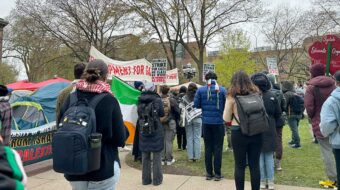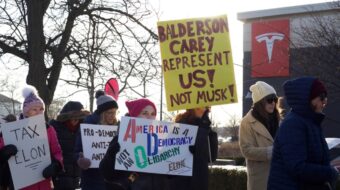SAN FRANCISCO – Immigrant rights activists around the country demonstrated July 29, the day Arizona’s anti-immigrant SB 1070, took effect, despite a temporary ban on enforcement of several of the law’s most onerous provisions.
Arizona’s capital, Phoenix, was the site of a number of protests. “It’s a good day to be arrested. We are going to challenge this law. We are going to keep up the fight,” former Arizona state Senate Majority Leader Alfredo Gutierrez said when he was detained after participating in civil disobedience.
After spending the previous night in a protest outside the state capitol, hundreds of demonstrators started the day with an early morning prayer service before marching to the capitol and to the office of notoriously anti-immigrant Sheriff Joe Arpaio in downtown Phoenix, where dozens were arrested.
Though the demonstrations delayed the action for several hours, Sheriff Arpaio launched his 17th anti-immigrant sweep through Maricopa County later in the day.
In Tucson, where a series of protests centered on the State Building, more than a dozen demonstrators were cited and released after they blocked downtown streets.
Among many actions around the country, demonstrators gathered in Raleigh and Charlotte, N.C., Providence, R.I., McAllen, Texas, Los Angeles and San Diego, Calif. In Brooklyn, N.Y., a coalition of immigrant rights organizations marched across the Brooklyn Bridge.
In San Francisco, protesters including members of the Board of Supervisors, the head of the labor council and Assemblyman Tom Ammiano gathered outside the office of Attorney General and gubernatorial candidate Jerry Brown to protest the Arizona law. They also urged Brown to let the city – long a “sanctuary city” for immigrants – opt out of the federal “Secure Communities” program, under which local police send fingerprints of jailed individuals to be matched against a federal database so immigration authorities can identify undocumented immigrants alleged to have committed crimes elsewhere.
San Francisco County Sheriff Mike Hennessy, with support of the Board of Supervisors, had asked Brown to let the city opt out of the program. Brown turned down the request, saying Secure Communities “serves both public safety and the interest of justice.”
As the group gathered in the foyer of Brown’s 11th floor office to speak with an aide, one of the most moving testimonials came from a young woman who said she is an undocumented student. Since she came to the U.S. at age 15, she said, “I have seen so much separation of families, separation of children from their parents.” Immigrants, often forced by social and economic factors to take the difficult step of leaving their homelands, “really contribute to this country,” she said. Anti-immigrant laws and decisions will not halt immigration, she said, “immigration will only stop when we address what causes it to happen.”
In Oakland, as immigrant rights supporters gathered at Fruitvale BART plaza in the heart of a largely Latino community, Netza spoke of his situation as he pursues a university education under the state’s AB 540 law, which lets undocumented graduates of state high schools attend public colleges for in-state tuition rates.
One of the biggest challenges, he said, is paying for college. Though he has a scholarship, many others do not, he said. AB 540 students are barred from applying for Pell Grants and other financial aid, he said, and with fees rising every year, some face costs as high as $20,000 a year – “an incredible amount for someone in my situation.”
Netza said he would like to see President Obama “set aside a day to talk about immigration reform, because that would not only benefit me and my fellow students, but my whole family, and others.” He also urged passage of the DREAM Act, a citizenship path for undocumented youth long resident in the U.S., which, among other things, would make financial aid a possibility for such students.
Photo: (Marilyn Bechtel/PW)











